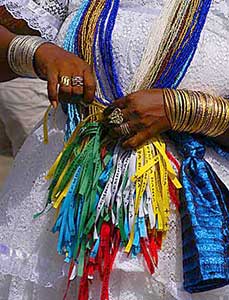The logo links the nature of the conference (a meeting of professional statisticians to reflect on education) and the regional flavour of the host city. It ties Statistics with the City of Salvador.
Two intertwined ribbons† (of Our Lord of Bonfim) are used in a stylised design that mimics a statistical graph. Allied to this are colours with vivid contrast — green and orange — that relate to the colourful, vibrant and tropical climate of Salvador.
The black text along with the orange and green ribbons generate the tricolour pattern very common in Bahian arts and crafts.
The font provides contrast between thick and thin, and straight and curved; the disorder of the letters creates a vibrant rhythm in harmony with the stylised ribbons.
 † Colourful ribbons (fitas) are widely sold around Salvador. A ribbon is worn knotted on the wrist, and the wearer can make several wishes. The ribbon must be worn continuously until it frays and falls off, by which time the wishes will be granted.
† Colourful ribbons (fitas) are widely sold around Salvador. A ribbon is worn knotted on the wrist, and the wearer can make several wishes. The ribbon must be worn continuously until it frays and falls off, by which time the wishes will be granted.
|
A logomarca liga a natureza do evento (encontro de profissionais de estatística para discutir o ensino nesta matéria) a umtoque regional que identifique a cidade anfitriã — a junção entre Estatística e a cidade de Salvador.
 Utilizou-se para tanto duas fitinhas do Senhor do Bonfim (em desenho estilizado) entrelaçadas que assumem a forma de um gráfico de dados estatísticos. Aliado a isso temos o uso de cores de contraste vibrante, o verde e o laranja. Esta combinação cromática, vigorosa e quente, remete ao clima tropical de Salvador.
Utilizou-se para tanto duas fitinhas do Senhor do Bonfim (em desenho estilizado) entrelaçadas que assumem a forma de um gráfico de dados estatísticos. Aliado a isso temos o uso de cores de contraste vibrante, o verde e o laranja. Esta combinação cromática, vigorosa e quente, remete ao clima tropical de Salvador.
O logotipo em preto, unido ao laranja e verde do símbolo gera uma assinatura tricolor muito presente no artesanato baiano.
A tipologia possui grande contraste entre as hastes finas e grossas, e entre linhas retas e curvas. Visando a harmonia com as fitas estilizadas, as letras são dispostas em desalinho, buscando criar um ritmo vibrante que se adequa bem ao contexto.
|